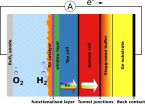(Press-News.org) Highly diluted acetic acid, an active ingredient of household vinegar, has been shown to be an effective alternative agent to prevent infection and kill bacteria found in burn wounds.
Researchers from the University of Birmingham and the National Institute for Health Research (NIHR) Surgical Reconstruction and Microbiology Research Centre (SRMRC) investigated the antibacterial activity of acetic acid against key burn wound colonising organisms growing both planktonically and as biofilms.
Burns are a common traumatic injury and prone to becoming infected due to loss of a normal skin barrier. Local infection of the burn wound and subsequent sepsis (blood poisoning) are key concerns for patients, with sepsis the leading cause of death among patients with burn wounds.
Infections of burn wounds are difficult to treat with traditional antibiotics as they do not effectively reach the wound, and the infecting organisms are often highly antibiotic resistant.
The study, published in PLOS ONE, demonstrated that low concentrations of acetic acid can be used to treat biofilms, and therefore could be used as alternatives to topical (surface applied) antimicrobials and traditional antimicrobial dressings for preventing bacterial colonisation of burns.
The current use of acetic acid in clinical settings has been limited due to concerns of patient tolerability. The finding that it is effective at far lower concentrations than previously thought therefore offers hope for the development of novel treatments.
Miss Fenella Halstead, NIHR SRMRC Clinical Scientist at the Queen Elizabeth Hospital, explained, "As resistance to antibiotics grows, we need to find ways to replace them with alternative topical agents that can kill bacteria and help our burns patients. The evidence in this study offers great promise to be a cheap and effective measure to do just that."
29 isolates of common wound-infecting pathogens including Pseudomonas aeruginosa, Acinetobacter baumannii, Staphylococcus aureus, Enterococcus faecalis, Escherichia coli, Klebsiella pneumoniae, and Enterobacter spp. were grown in the laboratory.
The ability of highly diluted acetic acid to inhibit growth of pathogens, prevent the formation of biofilms, and then eradicate pre-formed biofilms was tested on each isolate. Low concentrations of acetic acid (0.16-0.3%) were shown to be able to inhibit growth of all strains, prevent them from forming biofilms (bacteria attached to a surface) and also to eradicate mature biofilms for all isolates after three hours of exposure.
Previous clinical use of acetic acid as an antimicrobial treatment has used much higher concentrations of 2.5%.
Miss Halstead continued, "A key way in which bacteria cause infection is in a biofilm; where instead of living as single cells they form a community in the form of a slimy layer that we see on a wound, on a valve or on a catheter, for instance."
"As much as eighty percent of infections in the body are due to these biofilms which, typically, are even more resistant to antibiotics because they essentially have safety in numbers and their metabolic rate is a lot slower. For that reason, seeing that acetic acid was effective against all types of these pathogens was really great."
The team are now designing clinical trials with acetic acid in which they will test plain dressings soaked with acetic acid, against the more commonly used silver-based dressings. A further study will test the effectiveness of two specific concentrations of acetic acid on patients at the Healing Foundation Centre for Burns Research based at the Queen Elizabeth Hospital.
Dr Mark Webber, from the University of Birmingham, added, "Acetic acid, or more commonly, vinegar, has been used sporadically in medicine for the past 6000 years - being successfully implemented to treat plague, ear, chest, and urinary tract infections. So in that sense it's a well-known antimicrobial which has seen sporadic clinical application. Our work now gives a firm evidence base to guide the development of treatments which promise to be cheap and effective"
"These new trials will hopefully provide clarity on how this can be implemented for burns patients across the world. What we can say however, is more work still needs to be done to determine the best way in which to use acetic acid or similar chemicals to treat and prevent bacterial infection. We also need to study the way in which bacteria may adapt or evolve over time to exposure to these acids to again understand how they are effective and ensure any clinical usage is designed to minimise emergence of resistance as we have seen with antibiotics."
The team stress that people should not self-apply vinegar in the case of a burn however; but should go to hospital as normal. The acetic acid treatment would only be required in serious burns where infection can become a problem.
INFORMATION:
On Sept. 13, 2015, as NASA's Solar Dynamics Observatory, or SDO, kept up its constant watch on the sun, its view was photobombed not once, but twice. Just as the moon came into SDO's field of view on a path to cross the sun, Earth entered the picture, blocking SDO's view completely. When SDO's view of the sun emerged from Earth's shadow, the moon was just completing its journey across the sun's face.
Though SDO sees dozens of Earth eclipses and several lunar transits each year, this is the first time ever that the two have coincided. This alignment of the sun, moon and ...
New research from the University of Washington's Friday Harbor Laboratories shows that a more acidic ocean can weaken the protective shell of a delicate alga. The findings, published Sept. 9 in the journal Biology Letters, come at a time when global climate change may increase ocean acidification.
The creature in question is Acetabularia acetabulum, commonly called the mermaid's wineglass. Reaching a height of just a few inches, this single-celled alga lives on shallow seafloors, where sunlight can still filter down for photosynthesis. Like many marine creatures, the ...
UC San Francisco has received a National Cancer Institute grant of $5 million over the next five years to lead a massive effort to integrate the data from all experimental models across all types of cancer. The web-based repository is an important step in moving the fight against cancer toward precision medicine.
The goal is to accelerate cancer research to improve the way we diagnose, treat and conduct further research on the disease. The resulting database, called the Oncology Models Forum (OMF), will be accessible to researchers through the National Institutes of ...
Current drugs may stop working against the most common type of brain tumor in children, medulloblastoma, but the tumor could be targeted in a new way, according to Stanford University scientists.
In research to be published in the journal eLife, a team led by Prof. Matthew P. Scott at the University's School of Medicine tested a drug called Roflumilast in mice with a brain tumor that is resistant to Vismodegib, the drug in current use. Roflumilast is normally used to treat inflammatory lung diseases. It dramatically inhibited tumor growth from the first day of treatment. ...
This news release is available in French.
Montreal, September 15th 2015 - It is estimated that half of all cancer patients suffer from a muscle wasting syndrome called cachexia. Cancer cachexia impairs quality of life and response to therapy, which increases morbidity and mortality of cancer patients. Currently, there is no approved treatment for muscle wasting but a new study from the Research Institute of the McGill University Health Centre (RI-MUHC) and University of Alberta could be a game changer for patients, improving both quality of life and longevity. The ...
To better inform the tradeoffs involved in land use choices around the world, experts have assessed the value of ecosystem services provided by land resources such as food, poverty reduction, clean water, climate and disease regulation and nutrients cycling.
Their report today estimates the value of ecosystem services worldwide forfeited due to land degradation at a staggering US $6.3 trillion to $10.6 trillion annually, or the equivalent of 10-17% of global GDP.
Furthermore, the problem threatens to force the migration of millions of people from affected areas. ...
Solar energy is abundantly available globally, but unfortunately not constantly and not everywhere. One especially interesting solution for storing this energy is artificial photosynthesis. This is what every leaf can do, namely converting sunlight to chemical energy. That can take place with artificial systems based on semiconductors as well. These use the electrical power that sunlight creates in individual semiconductor components to split water into oxygen and hydrogen. Hydrogen possesses very high energy density, can be employed in many ways and could replace fossil ...
Amsterdam, NL, September 9, 2015 - The potential benefits of dietary cocoa extract and/or its final product in the form of chocolate have been extensively investigated in regard to several aspects of human health. Cocoa extracts contain polyphenols, which are micronutrients that have many health benefits, including reducing age-related cognitive dysfunction and promoting healthy brain aging, among others.
Dr. Giulio Maria Pasinetti, MD, PhD, Saunders Family Chair and Professor of Neurology at the Icahn School of Medicine at Mount Sinai, Director of Biomedical Training ...
OAK BROOK, Ill. - Imaging patients soon after traumatic brain injury (TBI) occurs can lead to better (more accurate) detection of cerebral microhemorrhages, or microbleeding on the brain, according to a study of military service members, published online in the journal Radiology.
Cerebral microhemorrhages occur as a direct result of TBI and can lead to severe secondary injuries such as brain swelling or stroke. The ability to monitor the evolution of microhemorrhages could provide important information regarding disease progression or recovery.
According to the Centers ...
CHARLOTTESVILLE, VA (SEPTEMBER 15, 2015). Management of Myelomeningocele Study (MOMS) investigators analyzed updated data on the effects of prenatal myelomeningocele closure on the need for placement of a cerebrospinal fluid (CSF) shunt within the first 12 months of life. These researchers reaffirm the initial MOMS finding that prenatal repair of a myelomeningocele results in less need for a shunt at 12 months and introduce the new finding that prenatal repair reduces the need for shunt revision in those infants who do require shunt placement. The researchers also found ...





